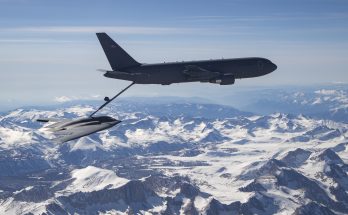By Derek Bisaccio, Forecast International.
About a year ago, on August 7, 2014, the Ukrainian Army launched an operation to capture the city of Ilovaisk, situated close to the border with Russia. Though the battle initially fared well, rebel fighters, reportedly aided by Russian regular soldiers, defeated the Ukrainian Army toward the end of the month.[i] The defeat and subsequent massacre of Ukrainian troops led to an agreement known as the Minsk Protocol that sought to emplace a ceasefire and establish political negotiations. The Minsk Protocol, as well as another one negotiated months later referred to as Minsk II, failed to stop the conflict or advance talks, as both sides accused the other of breaking ceasefire terms on a daily basis.
To keep up with the fighting, Ukraine sought assistance from abroad, particularly from the United States. Ukrainian President Petro Poroshenko came before the U.S. Congress on September 18, 2014, to request “both non-lethal and lethal” aid for his soldiers on the frontlines.[ii] Specifically, President Poroshenko was looking for weapons because, in his words, “blankets and night vision googles are important, but one cannot win a war with blankets.” Given the U.S. and NATO concern about getting too involved in an issue that Russia sees as directly linked to its own security, the United States has been cautious about providing military aid to Ukraine. The United States has largely refrained from sending the type of “lethal” aid Ukraine is seeking, sending instead “non-lethal” aid such as drones or HMMWVs (though this policy may be starting to change with recent speculation over a deal to send Javelin anti-tank missiles to Ukraine).
In any case, President Poroshenko did not seem to be anticipating a sudden surge in American military assistance. On August 25, 2014, as the fighting in Ilovaisk became increasingly dire for Ukrainian troops, President Poroshenko announced a $3 billion equipment modernization and procurement program for the period 2015-2017.[iii] To do this, Ukraine is mobilizing its immense military industry. According to data produced by the Stockholm International Peace Research Institute (SIPRI), in the years leading up to the conflict Ukraine was the world’s fourth largest arms exporter.
Ukraine’s top defense contractor Ukroboronprom went to work supplying the Ministry of Defense with its procurement requests. In October 2014, Ukroboronprom announced that it had delivered refurbished T-64 tanks, BMP-1 and BMP-2 infantry fighting vehicles (IFVs), and BREM-2 vehicles, as well as BTR-3, BTR-4, BTR-70, and BTR-80 armored personnel carriers (APCs).[iv] It also set to work restoring An-26 cargo planes.[v] Over the first half of 2015, Ukroboronprom stated it had transferred “797 units of weapons and equipment to the military,”[vi] with more to come. A month later, Ukraine’s Army received the first batch of modernized T-80 main battle tanks (MBTs),[vii] which supposedly came a month ahead of schedule.
As the deliveries keep coming, the overhaul looks set to continue for at least the next few years. The country recently increased the number of soldiers in the Army to 250,000, but to ensure that at least 60 percent of that force is composed of professional soldiers, Ukraine’s Defense Ministry needs a budget of $4.65 billion annually.[viii] This figure is more than double the budget for this past year. On August 6, 2015, Ukraine’s Prime Minister Arseniy Yatsenyuk stated that defense expenses would rise to 5 percent of GDP,[ix] up from 2-3 percent of GDP over the previous years. The additional expenditure will go to building new vehicles and repairing damaged ones, paying soldiers, and providing the Army with new equipment. All of this is intended to improve the conditions on the battlefield while also raising troop morale in order to keep support for the Army high and prevent defections to militias like Right Sector.
Paying for the rapid modernization could prove tricky, however. U.S. Treasury Under Secretary for International Affairs, Nathan Sheets, recently noted in an article for CNBC that the turmoil with Russia and conflict in Ukraine’s east have “delivered a blow to economic activity and productive capacity that has left Ukraine’s debts unsustainable.”[x] The International Monetary Fund and other international creditors have so far thrown Kiev a lifeline, but Ukraine’s continually contracting economy, high government debt, and ongoing conflict make the status of future bailouts unclear. These limitations will force Ukraine to continue to seek military aid, including weapons, from abroad, even as it works to modernize its military.
[i] http://www.kyivpost.com/content/kyiv-post-plus/witnesses-tell-about-attacks-on-ukrainian-soldiers-trying-to-leave-ilovaisk-at-least-100-killed-363204.html
[ii] http://www.cfr.org/ukraine/remarks-ukrainian-president-poroshenko-us-congress/p33470
[iii] http://www.janes.com/article/42317/ukraine-looks-to-multi-billion-dollar-rearmament-package
[iv] http://www.defensenews.com/article/20141012/SHOWSCOUT04/310120024/Ukraine-Puts-Priority-Vehicle-Protection
[v] http://www.ukroboronprom.com.ua/en/newsview/6/699
[vi] http://www.ukroboronprom.com.ua/en/newsview/7/693
[vii] http://www.janes.com/article/53010/ukraine-receives-first-modernised-t-80-mbts
[viii] http://www.defensenews.com/story/defense/land/2015/08/05/official-ukraine-must-boost-professional-troop-numbers/31184933/
[ix] http://en.interfax.com.ua/news/general/282412.html
[x] http://www.cnbc.com/2015/08/05/ukraine-needs-to-restructure-its-debt-commentary.html
For 50 years, Forecast International intelligence reports have been the aerospace and defense industry standard for accurate research, analysis, and projections. Our experienced analysts compile, evaluate, and present accurate data for decision makers. FI's market research reports offer concise analysis of individual programs and identify market opportunities. Each report includes a program overview, detailed statistics, recent developments and a competitive analysis, culminating in production forecasts spanning 10 or 15 years. Let our market intelligence reports be a key part of reducing uncertainties and mastering your specific market and its growth potential. Find out more at www.forecastinternational.com



